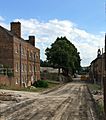Chatham Dockyard facts for kids
Quick facts for kids HM Dockyard, Chatham |
|---|
Chatham Dockyard was a very important place where ships for the Royal Navy were built and repaired. It was located on the River Medway in Kent, England. The dockyard started in Chatham in the mid-1500s. Later, it grew into the nearby town of Gillingham. Today, Chatham Dockyard and its old defenses are recognized as UNESCO World Heritage Sites.
The dockyard was built when England's relationships with some other countries in Europe were difficult. This meant England needed a stronger navy to protect itself.
For 414 years, Chatham Dockyard helped the Royal Navy by providing over 500 ships. It was a leader in shipbuilding and new industrial technology. At its busiest, more than 10,000 skilled workers were employed there. The dockyard covered a huge area of about 400 acres (1.6 square kilometers).
Chatham Dockyard closed in 1984. A large part of the old dockyard, about 84 acres (34 hectares), is now called the Chatham Historic Dockyard. It is managed by a special trust and is a popular place for visitors to learn about its history.
Contents
What Was Chatham Dockyard?
Chatham Dockyard was a key naval base for the British Royal Navy. It was one of the main places where warships were designed, built, and maintained. The dockyard played a huge role in Britain's power at sea for centuries.
Why Was It Built?
The dockyard was first set up in the 1500s. At that time, England needed to strengthen its defenses. Building a strong navy was very important for protecting the country. Chatham's location on the River Medway made it a good spot for a dockyard.
How Long Did It Operate?
Chatham Dockyard was active for over 400 years. From the mid-16th century until 1984, it was a busy center for naval operations. This long history shows how important it was to the Royal Navy.
Building Ships and Technology
Chatham Dockyard was known for its advanced shipbuilding. It was always at the front of new ideas and technology.
Skilled Workers and Innovation
Thousands of skilled workers, like carpenters, blacksmiths, and engineers, worked at the dockyard. They built and repaired many different types of ships. The dockyard was a place where new industrial and architectural methods were often first used.
Famous Ships Built Here
Over its long history, Chatham Dockyard built more than 500 ships. These ships were vital for the Royal Navy in many conflicts and explorations around the world. The dockyard helped Britain become a major naval power.
Chatham Dockyard Today
After closing in 1984, a large part of the dockyard became a heritage site. It is now a museum and visitor attraction.
The Historic Dockyard Trust
The Chatham Historic Dockyard Trust manages the site. Their goal is to preserve the dockyard's history and buildings. They also want to educate people about its importance.
What Can Visitors See?
Visitors can explore many historic buildings and ships. They can learn about shipbuilding, rope-making, and life in the Royal Navy. It's a great place to see how things were done in the past.
Gallery
Images for kids
-
The Dockyard as depicted by Robert Dodd in 1789
-
An old picture of "Chatham Dockyard from Fort Pitt" from 1831.
-
Dutch Attack on the Medway, June 1667 by Pieter Cornelisz van Soest.
-
Police Section House, one of the Dockyard's many listed buildings.

















































































